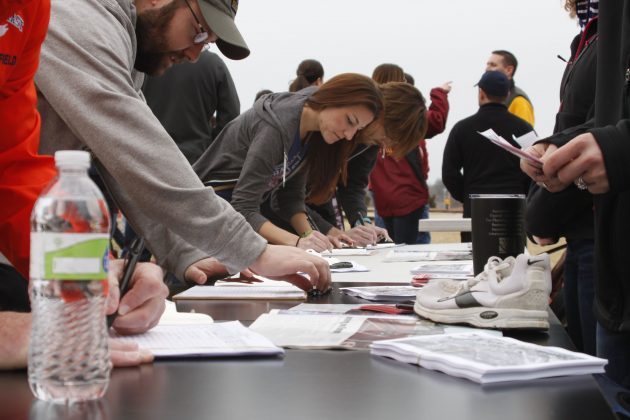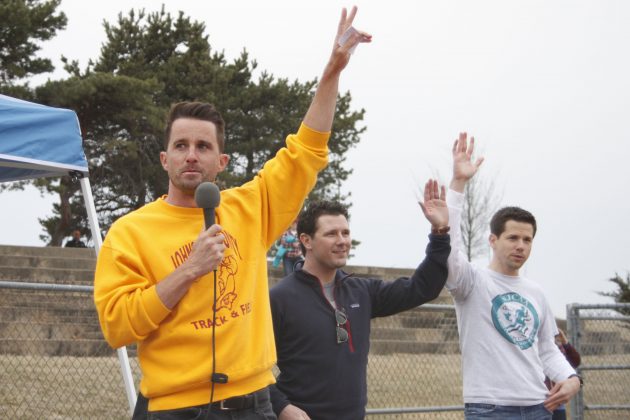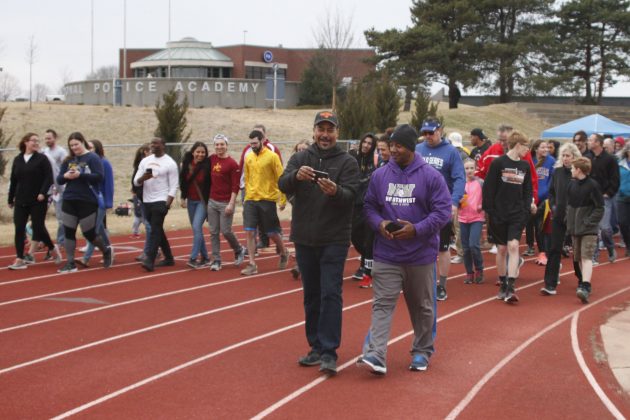
Margaret Mellott
Managing editor
mmellot1@jccc.edu
Walking onto the track today, the community was greeted with music, cold air and nearly 464 other people who are just as passionate about keeping the track programs.
Starting in January, the movement to save the track and reverse the decision has been at the forefront of many discussions, including those at Board of Trustee meetings.
The leading voice in this fight is Brian Batliner, alumnus and former coach, who spent months planning for the protest. Batliner said that today’s event was to show that the track’s destruction will impact more than just the college.
“We need to show how important it is to our community,” Batliner said.
One of the volunteers helping sign people in, Rachel Koger, said community efforts are important.
“[This is] overwhelming,” Koger said. “I knew that they had a lot of support, but I didn’t expect people to come out in the numbers they did … five minutes into the event start time and we’ve already got a couple hundred people here. I think it’s great to see the community here to support their effort.”
While the community played a big part in the event today, many cross country and track and field alumni showed up in support of keeping the programs.
In the many people who showed up, one family, the Webbs, has many ties to this track and said they found it important to show support.
Bethany Webb, alumna, said the track program forever changed her.
“I mean, it was everything,” Bethany said. “I was able to stay with my parents because I’m from up here. I was able to … save money that way … It was just an awesome opportunity for my education and I mean the track aspect of it, I wasn’t good enough to go to a four year right away, but I had mild success here … It just gave me the opportunity to pursue athletics and by the end of my time here I was able to go to a four year and compete at that level.”
Her dad, Aaron Webb said this impacts more than the immediate area. This impacts smaller towns surrounding Overland Park, Kansas.
“Here’s the point I’m trying to bring in … this is not just about Overland Park [and] affecting them negatively, it’s also affecting the area schools … Louisburg, Osawatomie and those schools where we had a lot of kids [from there] come here too,” Aaron said.
At 4:15 p.m., people began to gather at the start line near the bleachers. Batliner was the first of many to speak. The last speaker was the first track coach at the college in 1984, Dave Burgess. During his speech, he said even then, they knew the program was going to have a successful tradition.
“In 1984, I was asked to come over for introductions to the board … at the introductions … the first question that Carol Sader asked me ‘Well, we’re debating between an eight lane and a ten lane track’ and right away, I knew I was coming to a place I probably needed to be,” Burgess said. “So, they voted to build the track that we asked for and then they proceeded to ask questions about how great a tradition this was going to get started.”
In looking back on the program, Burgess said he didn’t understand why the program was cut.
“We stand here today on the brink of the program being eliminated and we wonder why they would choose to do that,” Burgess said.
When Burgess ended his speech, the microphone was handed back to Batliner for his closing thoughts.
“This is our track,” Batliner said. “This is our college. This is our community. Go back home, email your board members, tell your neighbors, tell your friends, tell high school coaches, tell your parents, this is important … We don’t quit, we’re track athletes … we just don’t quit until the very end.”
By the end of the protest, many people left with the same sentiment: save the track.



























